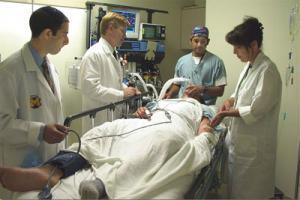Q: I need to know about shock therapy for depression. One of my characters is severely depressed and has tried all the medications. Is shock therapy still done? How is it done? Does it work? What are the complications?
A: Electroconvulsive Therapy (ECT) was and remains a very controversial topic. The truth is that it helps some people and others it doesn’t or might even harm. Unfortunately, that’s true of so much of medicine.
Major clinical depression is a common and significant medical problem. It robs the sufferer of all that is good about life. They are sad, lonely, see no future, enjoy no one’s company, avoid social activities, cry, and often fail to care for themselves. In its severest form, their clothes are dirty, they don’t bath, they eat poorly if at all, and as a result their health declines due to this personal neglect. The mortality rate in severe depression approaches 15 percent, mostly due to suicide.
ECT was discovered in the 1930’s. Over the years, many methods have been used to invoke the convulsions necessary for this type of treatment. Initially drugs were used, then insulin, which drops the blood sugar to such low levels that a seizure occurs. Finally, electric shock delivered to the brain was employed.
The mechanism of its action and benefit is poorly understood. It seems as though the chaotic electrical activity that rages through the brain during a generalized seizure somehow alters the “mood center” of the brain. No one knows for sure, only that the results can be dramatic.
In the early years, ECT was done without anesthesia so that when the seizures occurred the recipients would sometimes severely bite their tongues, vomit and aspirate, or even break bones in their extremities from the violent nature of the provoked convulsions. Pleasant.
In 1975, the movie One Flew Over the Cuckoo’s Nest hit the screen and painted a negative picture of ECT. Here it was used as a punitive device as opposed to a therapeutic endeavor. Currently, it is making a come back, because in many cases it works. Some studies report response rates of 80 to 90 percent as a front-line therapy and in those who have failed medical therapy, as in your character, it is effective in 50 to 60 percent of cases. Other experts refute this data. As with any therapy, relapses after ECT can occur.
I witnessed a couple of these during medical school. Not pleasant but in both cases it seemed to help. At least acutely. How it worked out long-term for these folks I don’t know.
The procedure is much less barbaric than it once was. The patient is placed on a stretcher, an IV is started, cardiac monitoring electrodes are placed on the chest, and the ECT electrode patches are applied to each side of the head. Either an Ambu bag with face mask is placed over the mouth and nose or an endotracheal tube is introduced into the trachea (wind pipe) in order to ventilate the patient during the procedure and until the anesthetic and muscular paralytic agents wear off. The patient is then given a short acting general anesthetic and a muscle relaxant, which prevent the outward manifestations of the seizure and thus prevent the tongue biting and bone breaking of the past. Short acting anesthetic agents used in this circumstance might include: Diprivan (propofol) 25 to 50 milligrams (mgs) given IV and repeated as necessary; or Versed (midazolam HCL) 2 to 5 mgs given IV and repeated as necessary. Both are fairly short acting so that their effects are seen immediately and wear off quickly. Muscle paralytics used might include: Norcuron (vecuronium bromide) 0.10 mgs per kilogram (1 Kg = 2.2 pounds) given IV; or Pavulon (pancuronium bromide) 1 to 4 mgs given IV. Each of these take effect immediately, their dosing can be repeated as necessary, and wear off over 20 to 30 minutes.

The physician performing the ECT pays close attention to the patient’s heart rhythm and airway, to prevent complications from aspiration or cardiac arrhythmias. The electrical current is applied to the brain and the seizure activity is induced, but since the patient is anesthetized and paralyzed, no tonic-clonic jerking, which happens in generalized seizures, occurs.
For severe depression, the treatments are given three times a week for six to twelve treatments or until the desired response occurs. Long term side effects appear to be minimal if any. Short term, there may be a dulling of cognitive function for a few days or weeks. Also, there may be amnesia, which can be retrograde (events that occurred prior to the ECT) or anterograde (events that occur in the period just after the ECT). In either case, these tend to resolve over a few days or weeks.
Besides this treatment being effective, it does not have the long term problems and side effects of the various psychotropic drugs used in the treatment of depression. Each of these medications has significant side effects and interactions with other medications and certain foods.
Possibly related posts: (automatically generated)
